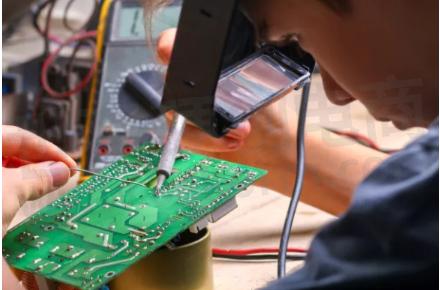Dark tide in the shortage market: chip refurbishment

Nowadays, the shortage of chips and the price rise seem to be the norm, and many players in the industry have begun to get used to it, and we are fully prepared to deal with the situation now. But as time goes on, there is an undercurrent emerging in the chip market, a market that used to be ignored, and it is growing: chip refurbishment.

The recent supply of foreign original factory products is still very tight. Stranger still, some downstream markets are booming, even as upstream original products are in short supply. For example, Huaqiangbei, which was gradually deserted in the past, has recently begun to welcome a large number of customers. A large number of enterprises and manufacturers even began to come here to find suitable chip products, which is interesting. The original factory does not have enough products, where are the goods of these businesses come from?
Recycled used chips
In recent decades, there has always been an emphasis on technology in China called overtaking in corners, but there is one technology that China has long dominated the world: reverse engineering. Of course, this technology is popularly known as "shanzhai".
If this technology is well used, it can quickly catch up with the international advanced level. After all, reverse engineering is actually a very serious and professional discipline. But many consumers, are most familiar with the shanzhai phones of the past, with common moulds, the same system, and even rumors that they could produce according to user demand within a few days with a trademark.
So now many downstream ports of massive chips, are all "copycats", the answer is not, of course, if the mobile phone can be a simple copycat, then now the market-released chips are basically refurbished products. After all, the technology is too high, and few people can do it.
Chip renovation is a technical work, according to an industry source, the main technical process of chip renovation is hot removal, washing feet, plating feet, grinding words, cover, lettering, and ribbon. However, the domestic chip renovation technology mainly comes from the Chaoshan area of Guangdong, and nine out of ten of the refurbished chips purchased in the market are from there.
And chip renovation has formed a mature industrial chain in China, many processes have been operated by machines, do not need to use of manpower. For Example, grinding words using a grinding machine, engraving words using a laser marking machine, in addition, to a cover machine, pad printing machine, ribbon machine, depleting pool, electroplating pool, test bench, etc.
In short, chip renovation technology is not the same as "Hanxin", simply polishing the trademark and changing it, but a complete process of professional technology.
Some viewers may wonder whether these technologies are for counterfeiting, or shoddy. Do not exclude the fact that some businesses do use cheap chips through renovation technology after posing as imported chips, or some white plate resistor-capacitor directly need what type of label printed on the behavior.
However, this market has existed for many years, and most buyers are not small. Some products whose prices are obviously lower than the market price are basically refurbished chips, and most sellers will clearly inform or mark them as refurbished goods.
Chip refurbishment is the reuse of electronic components, which is environmentally friendly and can reduce costs, and can be used as a backup option in emergency times. For example, in the current situation of a widespread shortage of chips, some enterprises rely on refurbished chips to survive. Of course, the premise is that the seller should explain the situation to the customer if it is too much to replace the old one.
The lucrative refurbishment market
If there are so many benefits to retrofitting chips, why should they be encouraged? This can be done if the market is regulated, but the problem is that since refurbished chips are still in a grey area and many of the rules are incomplete, there is a lot of room for inquiry.
Refurbished chips are mostly recycled products from discarded electronic products, so the chips themselves may have some problems. Some conscientious merchants will basically negotiate with customers and allow a certain proportion of bad films to be returned, which is also an unspoken rule of the industry.
But if you encounter unscrupulous vendors, you have to bear the cost of these damaged refurbished chips. Engineers said that the purchase of a batch of refurbished chips, although cheap, found that the damage rate reached 10%, chip damage is not related, with the product scrap is not cost-effective.
Some semiconductor factory procurement personnel revealed that most of the chips bought from the market are refurbished chips. After screening and testing before the machine is installed, only 40% of the final qualified products are found, meaning that 60% of the chips need to be eliminated.
It is understood that the price of the new chip is 21 yuan in the market, and the price of the refurbished chip is only 9 yuan, but the unqualified, loss of the chip, equivalent to a need of 22 yuan, is even more, expensive than the new chip. And even if the chips that pass the test are really used in the product, the stability of the chips is also worried because they are refurbished.
For example, some consumer chips themselves have a very short service life of only about five years. After renovation, the service life and performance of these chips are far inferior to the new chips.
Since refurbished chips may cause stability problems, they should no longer use these products, but in today's chip shortage market, perhaps purchasing refurbished chips is the only option for these companies to maintain production, and the problems they bring are on their own. After all, if there is no chip, it means that the factory will have to shut down. If there is no shutdown, it will have to change PCB or program, which will bring more cost, so many enterprises will choose to take some risks.
Chip market supply and demand imbalance, let the chip refurbishment market is growing. According to insiders, the recycling price of ST*32F103, for example, was 8 yuan per piece at the beginning of the year, but now it has risen to 24 yuan per piece, a threefold increase. Even the cost of chip refurbishment has risen from 0.8 yuan per chip to 2 yuan per chip.
But even so, there are still many vendors in the wantonly purchase, because in the market, such as ST*32F103ZET6 refurbished chip price has reached 50 yuan, and the price of the new product is even as high as 170 yuan, which means that the profit margin of the refurbished chip is as high as double.
The problem, of course, is that to do big business, you have to supply batches of the same chips, but where do these merchants get their supplies from? This may be their biggest trade secret, but as for the refurbished line, anyone with money can buy it.
How do you identify refurbished chips?
Why the chip must be refurbished to use, and can not be directly removed from the original product directly used? This is due to the direct removal of stitching is usually not straight, not clean, and the patch machine can not be affixed. It is necessary to remove the solder, clean it, and re-stamp the logo for a power test to ensure that the chip can be used normally.
Although some vendors will clearly tell customers that their products are refurbished chips, how will they tell which are refurbished chips if they are not informed?
First, the price is cheap. If the chip price is significantly lower than the market price, it does not mean that the leak is detected. It is likely that the refurbished goods are bought. Especially on shopping platforms, where some chips look cheap and some retail ones are delivered, nine times out of ten are refurbished chips.
Second, chip renovation usually re-tin pin, if the pin tin plating is not uniform, or pin brightness is not uniform, the probability is refurbished chip.
The third is to look at the appearance of the chip. If there are traces of polishing on the appearance, some models, fonts, trademarks, and other logos are fuzzy, which are basically refurbished pieces.
These are some ways to judge whether the chip belongs to refurbished parts from the appearance. Of course, with the progress of refurbishment technology, in many cases, it is difficult to tell whether it is refurbished products from the appearance. At this time, how to judge? There are ways.
For example, to identify whether the product is refurbished or fake, it is usually first welded to the PCB board or fixture and then powered on to see whether it is normal. If there is excessive current, heating, or even smoke, there may be a problem. Then read some information about the chip, such as Flash capacity, UID information, option bytes, etc., to judge whether the chip is genuine.
- +1 Like
- Add to Favorites
Recommend
- Summary of Chip Encapsulation Type-Is it Used with You?
- The RS3005 Chip Developed by Runic Technology Helped The System MCU to Complete The Power Supply
- FTDI’s USB Interface Chips FT232R Can Be Integrated into Gaming Controller
- Linear Power Supply Chip HKT6206 Can Be Widely Used in Reference Voltage Sources, Cameras and Other Products
- Bringing WIFI RF Front-end Chips, Low-noise Amplifiers, 5G Small Base Station RF Chips, CHIPBETTER Announced a Distribution with Sekorm
- 6 Bluetooth Beacons Based on nrf51822/nRF52832/nRF52810 Chip Solutions
- XBLW Chip Bo Le Analog Chip Series: Signal Chain Chips (Part 4)
- Focusing on design of security ASIC chip, NEOWINE provides anti-copy encryption chip, data security encryption chip, etc.
This document is provided by Sekorm Platform for VIP exclusive service. The copyright is owned by Sekorm. Without authorization, any medias, websites or individual are not allowed to reprint. When authorizing the reprint, the link of www.sekorm.com must be indicated.






























































































































































































































































































































































































































































































































































































































































































































































































































































































